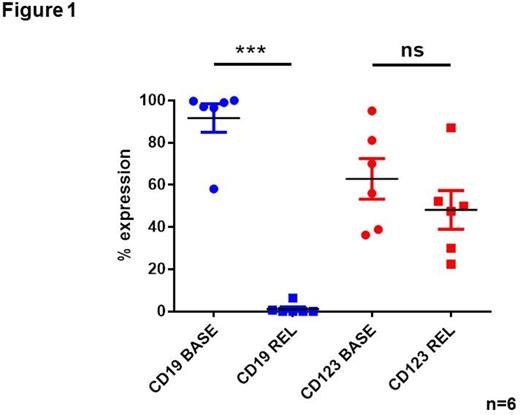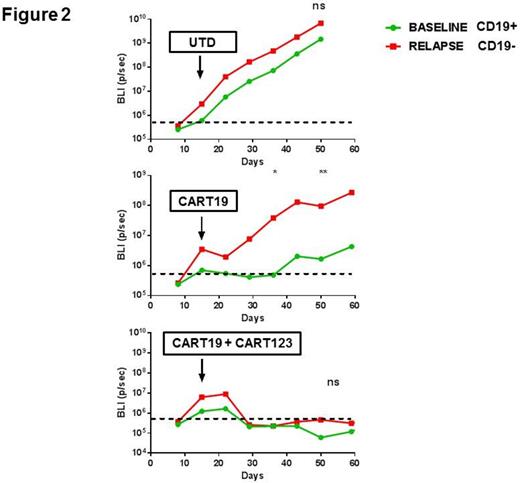Abstract
Introduction: Anti-CD19 chimeric antigen receptor T cells (CART19) and bi-specific anti-CD19/CD3 antibodies (blinatumomab) generate unprecedented complete response rates of 45-90% in relapsing/refractory acute lymphoblastic leukemia (r/r B-ALL). However, a subset of patients treated with these targeted approaches will relapse and a significant portion of these relapses are characterized by the loss of detectable CD19 (about 30% of relapses after blinatumomab and up to 50% after CART19), a clear manifestation of immunoediting. Hence, novel effective strategies are needed in order to be able to treat those patients and ideally prevent antigen-loss. CD123, the interleukin-3 receptor alpha, is involved in hematopoiesis and has been shown to be expressed in several hematologic neoplasms, including acute myeloid leukemia (AML) and more recently also B-ALL. Targeting CD123 with chimeric antigen receptor T cells (CART123) was shown to lead to deep and long-term responses in human primary AML xenografts. The goal of this study was to pre-clinically evaluate the impact of targeting CD123 and CD19 with chimeric antigen receptor T cells for the treatment and prevention of CD19-negative leukemia relapses occurring after CD19-directed therapies.
Results: We analyzed the expression of CD123 in 42 r/r B-ALL samples and found that CD123 is highly and homogeneously expressed on the surface of most B-ALL blasts (81.75%, range: 5.1-99.6), making it a promising candidate for targeted therapy in B-ALL. Moreover, CD123 was also found to be expressed in the putative leukemia stem cells (LSC), identified as CD34-pos CD38-neg. Notably, in some Ph+ B-ALL samples we found CD19-ve CD123+ve cells with a BCR-ABL translocation by FISH, suggesting that these cells too are malignant. The expression of CD123 was detected in all (n=6) CD19-negative B-ALL blasts analyzed after relapse from CART19 treatment (Figure 1). These findings indicate that CD123 represents an ideal marker to target CD19-neg ALL blasts occurring after CART19 or blinatumomab. Therefore, we generated anti-CD123 chimeric antigen receptor T cells costimulated with 4-1-BB using a lentiviral vector (CART123). We then evaluated the CART123 anti-B-ALL efficacy both in vitro and in vivo against primary B-ALL and cell line (NALM-6). CART123 showed intense anti-B-ALL ex vivo activity, as defined by specific CD107a degranulation, cytokine production, cytotoxicity and proliferation, not statistically different from that of CART19. In order to test the role of CART123 to target CD19-negative relapses we developed a novel in vivo model, engrafting immunodeficient NSG mice with blasts obtained from a patient relapsing with CD19-ve disease after CART19 treatment. At day 14 mice were randomized to receive CART19, CART123 or control T cells (untransduced, UTD). CART19 and control T cell treated mice had no anti-tumor activity, while CART123 led to complete eradication of the disease and long-term survival. We next developed a murine model to test the hypothesis that a combined approach simultaneously targeting CD123 and CD19 could treat and prevent CD19-negative relapses. NSG mice were injected with a mixture of primary CD19-neg and CD19-pos blasts from the same patient that were labeled with different click beetle luciferases (red or green) in order to be able to track the respective clones in vivo. Mice were then randomized to receive UTD, CART19 or the combination of CART19 and CART123 (same total dose of T cells). As shown in Figure 2, mice treated with UTD had progression of both leukemic clones (CD19-pos and CD19-neg) while CART19 showed rapid progression mostly of the CD19-neg disease (red luciferase); on the contrary only mice treated with the combination of CART123 and CART19 showed rapid clearance of the disease, with improved overall survival (64 days for CART19, not reached for CART19+CART123). As a final strategy, we expressed both CAR19 and CAR123 in the same T cells and showed potent anti-leukemia activity (CD107a degranulation 81.7%).
Conclusions: Here we demonstrate that CD123 is expressed in CD19-negative B-ALL relapses occurring after CD19-directed therapies, and that combining CART123 cells with CART19 cells is an effective therapy for the treatment and prevention of antigen-loss relapses in B-ALL murine xenografts.
Ruella:Novartis: Patents & Royalties, Research Funding. Kenderian:Novartis: Patents & Royalties, Research Funding. Scholler:Novartis: Patents & Royalties. Lacey:Novartis: Patents & Royalties, Research Funding. Melenhorst:Novartis: Patents & Royalties, Research Funding. Hunter:Surface Oncology - SAB: Membership on an entity's Board of Directors or advisory committees, Research Funding. Porter:Novartis: Patents & Royalties, Research Funding. June:University of Pennsylvania: Patents & Royalties: financial interests due to intellectual property and patents in the field of cell and gene therapy. Conflicts of interest are managed in accordance with University of Pennsylvania policy and oversight; Novartis: Research Funding. Grupp:Novartis: Consultancy, Research Funding. Gill:Novartis: Patents & Royalties, Research Funding.
Author notes
Asterisk with author names denotes non-ASH members.



This feature is available to Subscribers Only
Sign In or Create an Account Close Modal